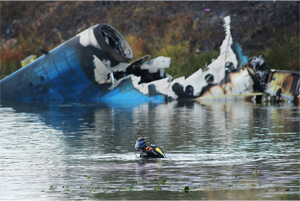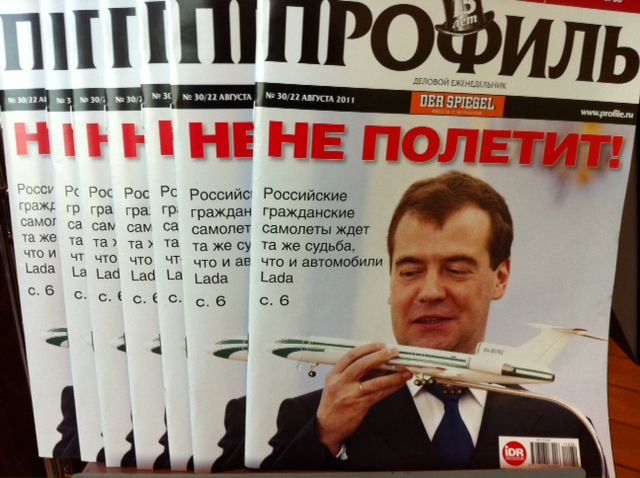Kasparov: Look to Medvedev in Yaroslavl Tragedy
 A Case of Misoperation
A Case of Misoperation
By Garry Kasparov
September 14, 2011
Kasparov.ru
The terrible tragedy at the Yaroslavl airport has given new relevance to the discussion about the deterioration of Russia’s air fleet. Indeed, statistics eloquently testify to the fact that the number of airplane catastrophes in Russia even outstrips those in African countries. Affairs in our aviation industry are in a deplorable state – the ruling Russian regime, having freeloading off of deteriorated Soviet infrastructure for the past two decades, has turned out to be incapable not only of developing the only branch of industry that could easily compete in the global market, but even of keeping it afloat. Costing it an incredible amount of strain, the arms race forced the USSR to maintain parity with the US in the aerospace industry, which allowed Soviet aviation, in addition to high-class military technology, to produce fully reliable civilian aircraft. While they do have clearly inferior-quality engines, avionics, and, of course, interior, the aerodynamic characteristics of Soviet planes nevertheless frequently surpassed their foreign colleagues.
On a recent episode of the Polny Albats radio show on Ekho Moskvy, Rector Konstantin Sonin of the Russian School of Economics disdainfully dismissed my mention of the successes of the Soviet aerospace complex – there was no place for the support of the domestic aviation industry in Gaider’s macroeconomic model. In lock-step behind his spiritual advisor Yevgeny Yashin, who tirelessly insists on triumphantly establishing a market economy in Russia, Sonin can only throw up his hands and lament the fall of domestic airplane construction.
The market, you know, regulates supply and demand on its own, and any interference by the state in this delicate process only disturbs the harmonious work of the market mechanisms that have been set up in our country. I would like to ask our homegrown liberal economists how the existence of AvtoVAZ figures into this harmonious scheme, since it continues to release its antiquated products as if nothing had happened and survives only thanks to various forms of state protectionism. In the company of refined British gentlemen, the invisible hand of the market does its work, but everything in the Russian “market” economy is governed by the avaricious paw of administrative resources, always followed by the muzzle of a civil servant grinning in anticipation of some new tasty morsel.
But the cars coming off AvtoVAZ’s conveyor belts have always brought a certain immediate advantage to the people controlling the production process, whether it be the mobsters of the tumultuous ’90s or Putin’s cronies of the stable ’00s. But investment in airplane construction has, as we know, the longest period of returns, stretching far past the limit of the commercial accounts of Russian civil servants and oligarchs. No major infrastructure projects in Russia can begin without the state’s direct involvement, and civil servants, depraved by quick and easy gas and oil dollars, see no reason to authorize long-term investment.
Because of its inextricable natural defects, the oligarchic and bureaucratic capitalism that has been established in Russia under the guise of “liberal reforms” has been incapable of providing the country with a model of sustainable economic development. Mikhail Prokhorov’s bravado-filled monologue has demonstrated once again the complete creative impotence of the Russian billionaires who flood the Forbes lists.
However, externally, the catastrophe in Yaroslavl differs markedly from other similar cases. First of all, the flight was far from typical, which, considering the very high social status of the passengers, presupposes a heightened level of attention to the quality of the flight. And the plane itself was built not so long ago – in 1993, and its last technical inspection was on August 16.
The initial speculation about the reasons for the catastrophe, which had to do with a defective motor or poor-quality fuel, have been refuted, which leaves the remaining possible explanations as either a mistake by the flight crew or a mistake by the ground crew that regulate flights at the airport. Of course, it is too early to come to any conclusions, but the basic circumstances at the airport on the day of the tragedy allow us to speculate that it was precisely the chaos caused by the arrival of the high-level leadership to the World Economic Forum that was the main reason for the catastrophe.
The plane crashed when it failed to gain enough height after takeoff, which almost certainly was caused by an insufficiently long time on the runway or something that appeared in its way. Either of those causes would be directly connected with the work of the airport’s ground crew responsible for takeoffs and landings. There’s no doubt that, on that day, the dispatchers were accompanied by Federal Protective Service officers called upon to ensure the safety of the flight of the state’s highest-ranking figures. We can also recall the crash of the Polish leadership’s plane in Smolensk, when the Russian dispatcher evidently acted on the orders of the leadership, which gave him orders based on political expediency and not aviation security.
By the way, it is not likely to be anytime soon that we will learn the name of the security services officer who probably gave the fatal order to shorten the length of time before takeoff for the Yakovlev-42 that crashed on the runway at the Yaroslavl airport. In today’s Russia, investigations of catastrophes that are in one way or another connected to the high-level leadership are never resolved. Or, the guiltiest parties are always said to be those who, by the will of fate, got in the way of the definitively unrestrained “bosses of the country.” And we can already see how the barometer of the investigation, which is subject to the inexorable laws of the pull of Russian politics, is indicating that the actions of the deceased pilots to supposedly “incorrectly choose the mode of engine operation” was the main reason for the tragedy…

P.S. This cover for Profile magazine can be wholly qualified as a frightening prophecy. The Yakovlev-42 was indeed unable to take off in Yaroslavl, and it very much seems that, even if only indirectly, Dmitri Medvedev had a hand in it. Medvedev himself continues to soar in the political skies all the same, although he doesn’t look much like an eagle. He’s more of a hummingbird – a tiny bird with beautiful wings who buzzes loudly, is extraordinarily greedy, and most importantly, is capable of flying backwards.
Translated by theOtherRussia.org.
